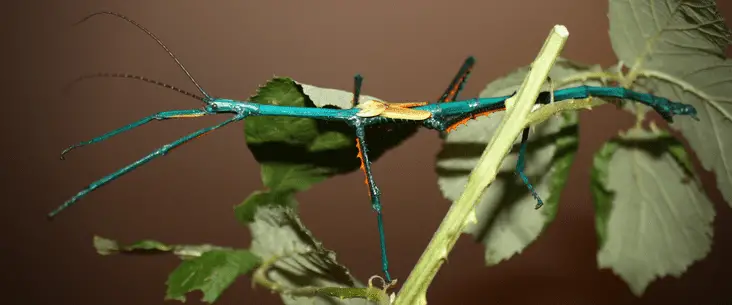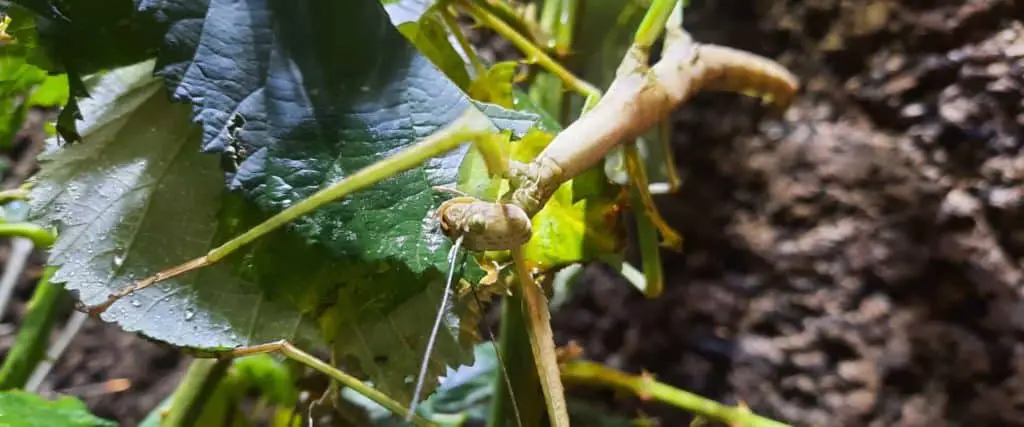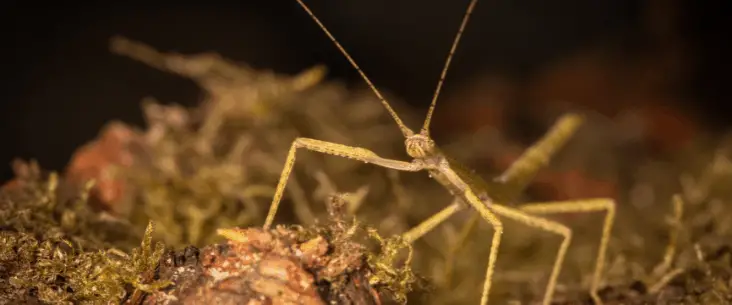Stick insects are great and easy pets to have. And they are popular too! When you search for them in online pet shops, they are quite cheap to purchase. But keeping pets is more than only purchase them. You also need to house them and feed them. So, what are the real costs of keeping stick insects? This article will discuss all the costs you probably make when keeping these bugs as pets.
The average initial investment to keep stick insects is between $150 and $380. The upkeep and care of stick insects will have an additional yearly cost between $10 and $45. This makes keeping stick insects quite cheap compared to the more popular cats and dogs (around 500% cheaper).
| Product category | Initial costs | Yearly costs |
|---|---|---|
| Purchase stick insects | $10 – $40 | – |
| Terrarium | $100 – $250 | – |
| Climate | $40 | $10 – $15 |
| Furniture & decoration | $0 – $10 | $0 – $10 |
| Accessories | $0 – $20 | – |
| Substrate | $0 – $20 | $0 – $20 |
| Food | $0 | $0 |
| Total costs | $150 – $380 | $10 – $45 |
I have calculated the costs based on keeping and caring for a small group of up to 6 stick insects. Of course, costs will increase when you keep larger groups. You’ll need to have a larger enclosure and keep that enclosure on temperature. If you keep on reading, you find what you’ll need for keeping insects and how much all these supplies cost.
The cost breakdown
As you will probably know, keeping pets is more than just buying them. The care for them also cost money. For cats and dogs this is quite well documented, but for stick insects… What’s the point of only knowing how much the animal itself cost when there are essential supplies needed to take good care of them?
We have split the costs into initial costs and yearly costs. There are just some things you need to purchase before you can properly keep these awesome pet animals. Essentially you make these costs once, at least if nothing breaks.
On the other hand, we discuss the costs you will yearly make to keep them. And yes, even if stick insects only live for one year, because they are easy to breed, you can easily maintain a group of them for many years. After the initial purchase, you resupply yourself with new animals as a matter of speaking.
Just want to know what you need? Check out this shopping list!
– A good small-sized enclosure: Zoo Med Naturalistic Terrarium 18″ x 18″ x 24″
– The perfect large-sized enclosure: REPTI ZOO Reptile Glass Terrarium 24″ x 18″ x 36″
– A heating set for stick insects: Reptile Heating Lamp With Bracket And Adjustable Temperature Switch
– Proper substrate (optional): Zoo Med Eco Earth Loose Coconut Fiber
– Cork background for your enclosure (optional): Cork background
– Spray bottle to keep up the humidity: Spray bottles
If you don’t have this already:
– Work gloves for trimming bramble: SAFEAT Safety Grip Work Gloves for Men and Women
– Pruning shear for trimming feeding plants: Fiskars Softgrip Bypass Pruner
– Bottle for your food plants: Bud Vases
Initial costs to keep a stick insect
The initial costs are the things you just need before you can keep them. It is not only the purchase of the animals but also the items you need to properly house and care for them. So, we first take a look at the upfront costs when you start keeping stick insects.
Purchase price — how much does a stick insect cost?
The first and most obvious is the cost of the animals themselves. You have to decide which stick insect you want to keep. Where a single adult of some species can cost up to $25 dollars, generally you pay $5 to $20 for 10 eggs. Some rare or unique specimens can cost even more, but you won’t come across these species very often.
There are several factors that affect the price. First adult and mature specimens cost more than eggs. But because they live such a short life it would be best to start off with eggs. It would be best if you start with two batches of eggs, the first 10 eggs when you have set up your enclosure, and a second batch when the first batch is hatching.
Why you might think? Because most stick insects only have a life expectancy of around 1 year, you will have hatched specimens longer and increase the chance of continuous successful breeding.
So the initial purchase price will be around $10 and $40 for 20 eggs in total.

Enclosure
A proper enclosure is maybe the largest expense you have when keeping stick insects. Although you have cheaper options, like adjusting a plastic container, a proper terrarium is more enjoyable to watch.
But even with terrariums there are different options and different price ranges. A good sized terrarium to house around 20 stick insects will cost between $100 and $250, depending on brand and size of the terrarium.
For smaller stick insects you can go for a terrarium with a size of 12″ x 12″ x 18″ (30cm x 30cm x 45cm). Height is more important than width, so you should look for enclosures that are tall. Exo terra and Repti Zoo have good terrariums to keep stick insects.
Important features that the enclosure need are good ventilation and good access to place feed plants in the enclosure. A mesh lid is highly recommended.
Recommended read: How to set up a stick insect enclosure in 7 easy steps!
Climate
Stick insects will only thrive when you provide an optimal environment for them. They need a good temperature, humidity and lighting. So, what do you need to buy to create a proper environment for them?
Temperature — Many stick insects can be kept at room temperature, but would do even better when they are housed slightly warmer. The optimal temperature range for most stick insects is between 68°F and 83°F (20°C-28°C).
Unless you live in a steady warm climate or like to have a high room temperature, additional heating is desirable. A simple 35W to 50W light bulb above the enclosure is sufficient to add some additional heat. You can also use a heating pad, but because stick insects need a light cycle as well a regular light bulb has the preference.
You can have a simple lamp standard including a bulb for around $35. Heating pads are available for as cheap as $10 up to $35, depending on the size and wattage.
Humidity — Stick insects like to have it slightly moist, but don’t need any fancy equipment. A spray bottle is sufficient to slightly increase the humidity and keep the feeding plants fresh. It also provides water drops for the stick insects to drink. Good spray bottles are already available for around $5.
Lighting — Stick insects need some light cycle to stimulate feeding and breeding. A 12h light and 12h dark cycle is perfect for most of them. If you have a window in the room where you want to keep your stick insects you don’t need specific lighting. And oftentimes the heating lamp provides the needed light already.
Good Practice Tip: Never place an enclosure in direct sunlight. This can heat up the enclosure quickly, overheating your stick insects in no-time. Stick insects can’t handle such extreme temperatures and will dry out and die.
Besides the investment, there are some little yearly costs to keep them in the right conditions. Based on the average price for electricity and the amount of use for heating and lighting, it will cost you around $10 to $15 a year. The costs to keep the humidity high enough and provide water for them to drink can almost be neglected. The cost will be less than $0.01 a year, so you don’t have to worry about that.
Decoration & accessories
You can go completely crazy when decorating the enclosure. If you like you can create a beautiful enclosure that resembles the natural habitat. Especially if it is a centrepiece in your living room.
But you need at least some climbing and perching opportunities for your stick insects. This is easily done by providing some twigs and branches. Don’t place too many, however, because you also need space to place the feeding plants for them.
At the basics, it doesn’t cost you any money. Branches can be gathered from your backyard or local forest. If you like plants, you can collect them from outside as well. As long as you make sure it isn’t sprayed with any chemicals or pesticides. This is even more important when you buy decorating plants from the garden centre. Those plants are often treated with pesticides to keep bugs away.
Maybe you need to update the decoration once in a while or refresh some plants or mosses in the enclosure. But it won’t cost much money for the relatively small enclosure. And if you collect plants from nature, it won’t cost you anything at all.
Stick insects don’t have high requirements, and setting up an enclosure is rather easy (and quite cheap, too!).
Yearly costs to care for a stick insect
The initial costs are most of the costs to keep stick insects. After you bought the enclosure, created an optimal climate, and decorated the enclosure, you won’t have much spending to make. However, there can be some recurring costs.
Substrate
We already talked about the recurring costs of decoration. Although you can do it for rather cheap (or even free), you’ll need to do some refreshing to the enclosure once in a while.
It is the same when you use a substrate. Most stick insects don’t necessarily need a substrate, and then it is only used for esthetic reasons. Simply said, to make the enclosure more beautiful.
However, some stick insects need a substrate to burrow their eggs. In these cases, you need to provide a good layer of a substrate, and also refresh it once a year.
Substrate doesn’t cost much. For a surface of 12″ x 12″ (30cm x 30cm), a layer of the substrate will cost you around $20 a year.

Food
Normally, food will take a chunk from the pet costs, but this is not the case for stick insects. Most stick insects will eat bramble, oak and rose. You can find all of these plants outside in your garden, local park or community forest. And therefore, it is free and of no charge to collect these plants to feed them to your stick insect pets.
Bramble is often considered a pest plant, and most people are glad when you slowly cut it down. So have a look around and talk with people so you may cut down their bramble in their garden.
Important to consider is that the plants are not treated with pesticides. So plants that are close to farmland should be avoided. Always check with people if they not sprayed any insecticides in their garden. When you feed one plant treated with these chemicals, it can quickly be done with your whole stick insect population.
Recommended read: What to feed stick insects: A helpful guide
Are stick insects cheap pets to own?
Can you consider stick insects as a cheap or expensive pet to own? Well, this is very subjective. But, if you compare it to other common pets, I think you can consider stick insects are quite cheap. Where cats cost yearly between $430 and $870, and dogs between $430 and $1170, stick insects only cost between $10 and $45 a year.
Stick insects don’t have high demands, and an initial investment between $150 and $380 is very reasonable. For this amount of money, you generally can buy only one cat house or proper dog bed. Even compared to other bug pets, stick insects are quite cheap. That is mostly because they don’t have a high climate demand (at least most of them), most don’t need high-quality substrate, and you don’t have to buy them food. Generally, insect-eating bug pets are more expensive.
Are there ways to save money?
Can you keep stick insects on a budget? There are ways to save some money when your budget is limited. Let’s talk about what you can do to save some bucks.
The first thing you can save a considerable amount of money on is buying a cheap(er) enclosure. Now, terrariums can be relatively expensive. But you can also keep stick insects (depending on the species) in faunariums. These plastic terrariums are quite cheap and practical. You can still enjoy your lovely stick insects, but the enclosure will not look that pretty as with a glass terrarium. Faunariums are available already from around $10.
You can also look for plastic containers that you modify to house stick insects. The difficulty is to find containers that have a good height, although you can place them on the side to create the needed height for your animals. Faunariums are often on the smaller side, so if you like to keep larger stick insects, a plastic container could be the choice for you.
Another way to save money is to keep stick insects that you can house at room temperature. Then you don’t need an additional heat source to keep them warm. Also, choose a stick insect that doesn’t need substrate to burrow its eggs so that you can save on the substrate as well.
Much more to learn!
There is much more to learn about stick insects. For example, do stick insects need a substrate? You can find more articles about stick insects with plenty of practical tips to better understand and enjoy the keeping of stick insects as a pet. Want to know more about the basics of keeping stick insects? Check out our basic guide about caring for stick insects.
Share this page!



